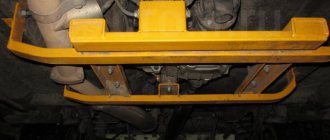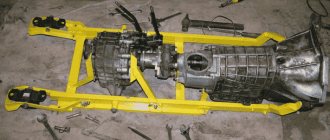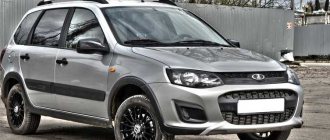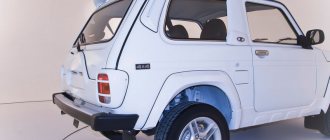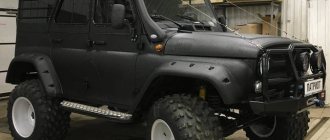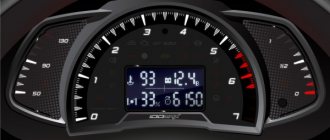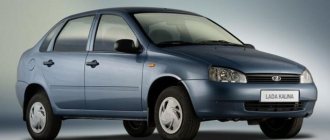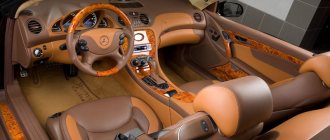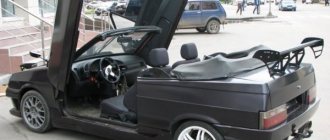VAZ-2121 Niva and Lada 4x4
VAZ-2121 Niva and Lada 4×4.
Unfortunately, the original three-door Niva lost its name when AVTOVAZ and GM entered into an agreement to jointly assemble the new Niva - VAZ-2123. Along with the new model, the American concern also acquired the legendary Niva brand. VAZ-2121 Niva and Lada 4×4.
Unfortunately, the original three-door Niva lost its name when AVTOVAZ and GM entered into an agreement to jointly assemble the new Niva - VAZ-2123. Along with the new model, the American concern also acquired the legendary Niva brand.
Body
The car body is of a supporting structure, three-door, all-metal. The body shell is a welded structure assembled from panels, side members, cross members, struts and various reinforcements.
Side doors with a front hinge have two safety glasses: the front one is rotating with a handle and a lock, the rear one is sliding glass driven by the window lifter handle. The tailgate is hung on the body on two hinges and is locked with a lock. The door is held in the open position by gas-filled stops. The rear door sill is lowered to the level of the bumpers, making it easier to load and unload cargo.
Window and rear windows with panoramic glass. The windshield is polished, three-layer, and the back and sides are hardened.
The front seats are separate with reclining backrests and have a mechanism for adjusting the seat position and backrest tilt. The rear seat is common, folding to form a cargo area.
The VAZ-21214 differs from the VAZ-21213 by installing an engine with a fuel injection system. This system ensures compliance with 1983 US emissions regulations and also improves vehicle performance. Changes to the engine concern the power supply system, ignition and exhaust gases. Features of the fuel injection system are described in section Fuel injection 21214.
Due to the use of complex technological equipment and the need for high-quality work, it is recommended that the treatment of hidden cavities be performed only at car service stations.
The procedure for performing operations to protect hidden cavities from corrosion:
- place the car on a lift, remove parts and upholstery that prevent access to hidden cavities;
- rinse with water at a temperature of 40-50°C through the technological and drainage holes, hidden cavities (Table 8-2) and the bottom of the body until clean water flows out. In this case, the sliding windows of the doors must be raised;
- remove moisture that has entered the passenger compartment and luggage compartment, blow with compressed air all areas where the anti-corrosion compound was applied;
- Drive the car into the chamber for applying the anti-corrosion compound and place it on a lift. Spray anti-corrosion compound to the areas shown in Fig. 8-6, 8-7 and 8-8;
- lower the car from the lift, clean the front surfaces of the body from dirt with a rag soaked in white spirit.
Rice. 8-6. Hidden cavities (front view of body):
1 – upper cross member of the front end; 2 – headlight housings; 3 – lower cross member of the front end; 4 – under the front wing; 5 – external threshold; 6 – internal threshold.
Rice. 8-7. Hidden cavities (rear view of the body):
1 – rear side members; 2 – between the rear wheel arches and the sidewalls; 3 – rear side members; 4 – rear floor cross members; 5 – central pillars; 6 – front door pillars; 7 – door pockets.
Rice. 8-8. Hidden cavities (body view from below):
1 – front side members; 2 – connectors of the front side members; 3 – middle spars; 4 – connectors for middle side members; 5 – rear floor cross members; 6 – rear side members; 7 – rear cross members.
Looking back at the year of my life completely spent on the Niva, I remember what was done and what should have been done differently... And some things, probably, we did in vain...
I DON'T HAVE TO DO IT AS BEST, DO IT AS WELL!
Lada 4x4, VAZ-21214, as well as all other SUVs that we historically call “Niva”, have several obvious advantages and no less obvious disadvantages, most of which are revealed only during operation. For some time now, the main advantage of the Niva has been its price. Let me remind you that this was not always the case and, for example, in Soviet times, a VAZ-2121 cost 9,900 rubles, only slightly inferior to the Volga in this indicator. In fact, it was the only versatile SUV on the market. LuAZ was completely utilitarian, and buying a UAZ for private ownership was extremely difficult, that is, almost impossible. At the same time, if we remember that a Zhiguli, say, the fifth model, cost 5,300, then it becomes clear why there were no queues for the Niva. In the late eighties, the VAZ-2121 was even sold in installments (as, by the way, was the Moskvich). Now try to find a Niva of that time in decent condition! And especially in determining this decent condition is the body. This is the first thing I strongly recommend that a young man who is planning to buy a VAZ SUV pay attention to. And I don’t even mean the presence of rust, the strength of the side members and other strength elements, but the mandatory and indispensable anti-corrosion treatment. Even if the body is strong and the “red plague” is not visible, believe me, half of the winter it will appear even in a five-year-old car. The body of the Niva is load-bearing - that is, each element is, in fact, a force-bearing one. Any corrosion, especially advanced corrosion, especially through corrosion, plus vibration, plus loads when driving off-road - and then only expensive body repairs with reinforcement, welding, aluminum linings and scary-looking “extenders” of wheel arches. So, the first stage is anti-corrosion. You may ask, is it worth filling your car with popular and varied protective coatings? Yes, if you have money and the first stage is completed perfectly. This is beautiful, practical and well complements the preservation of the body, since the paintwork scratches easily and blooms instantly (you can read about a similar experience with our Niva and Titan in issue No. 12/2016 of our magazine).
VAZ-2121 Niva
The interior of the Niva in the first years of production looks more interesting than the current version.
Instruments in individual wells, large signal lamps with chrome frames. Plus a Soviet “fetish” in the form of a steering wheel braid and gearbox knob with a rosette. The interior of the Niva in the first years of production looks more interesting than the current version. Instruments in individual wells, large signal lamps with chrome frames. Plus a Soviet “fetish” in the form of a steering wheel braid and gearbox knob with a rosette.
Classic
The Classic package is basic with a price tag of 588,000 rubles for the three-door version and 631,000 for the five-door body. The car is shod with regular 16-inch tires. Head lighting is represented by round halogen headlights. The front and rear bumpers, door handles, and rear-view mirror housings are matte black.
Despite the cost of this configuration, there will be two electric windows in front. Safety systems include a side airbag, ABS, brake force distribution unit, auxiliary braking module, ERA-GLONASS, and an isofix child seat mount.
There are two speakers in the cabin, but no radio. The latter is available for an additional fee with support for AUX and USB connectors. Additional features worth noting include a curtain in the trunk, as well as a full-size spare tire. Optionally, the basic package can be expanded:
- central locking;
- remote control key;
- package “for smokers in the cabin”;
- alarm.
VAZ-2121 Niva
“Six” instruments today cannot be considered the standard of information content - the arrows sometimes deviate to the side when cornering or when braking.
But this toolkit looks great. “Six” instruments today cannot be considered the standard of information content - the arrows sometimes deviate to the side when cornering or when braking. But this toolkit looks great.
Niva California - design project of a new Lada 4x4.
The annual transport design exhibition Automania, which takes place in Yekaterinburg, presents works by authors from various regions of the country and the world. Thus, a young designer, Denis Ponyatov, originally from the city of Tolyatti, brought his creation of an SUV from AvtoVAZ to public view. The car received a futuristic name - Niva California. The prerequisites for such a specific name were the plant’s deliveries to the United States in the late 90s of models with the same name.
The works of another 50 design artists were also on display, including representatives of universities in Germany and Russia, and workers from the studios of world auto giants (Peugeot, Volkswagen, Citroen).
The roof of the Lada California had a sliding sunroof, made of fabric and acting as a roof. Denis suggests replacing the material with solar panels, installing them a little higher, which will give the car interior additional space.
As for the design itself, the author suggests installing the rear part of the Niva California on its own frame, slightly extended. However, this innovation is only a design move, since reality is unlikely to allow the idea to be brought to life, due to the need to maintain minimum clearances of body panels.
The Togliatti designer does not plan to stop there and in the near future plans to present to the general public his latest developments, which will be dedicated to the future generation of the new Niva.
Also interesting: All-terrain vehicle Petrovich: what characteristics does it have, price, video
Video material dedicated to Niva California
VAZ-2121 Niva
The high side makes loading heavy items difficult.
But before, the trunk could be opened from the outside, whereas a modern car allows you to do this only from the interior. The high side makes loading heavy items difficult. But before, the trunk could be opened from the outside, whereas a modern car allows you to do this only from the interior.
Design
The long-awaited update of the Lada Niva 4×4 slightly upset fans of the SUV, as more was expected. There have been virtually no changes to the exterior. The manufacturer only changed the front bumper, installing fog lights in it, and the external rear-view mirrors - with larger “mugs”.
The main innovations of the restyling are in the interior of the SUV. Firstly, the finishing materials have been improved - both plastic and upholstery. In addition, the dashboard has become more modern. The latter was borrowed from LADA Granta. The front panel has been updated, receiving more rounded and modern shapes.
And also interesting: Fame in social networks: the whole world came up with a name for the new Lada | Articles | News
All switches on the center console have an improved appearance, and there is space for a radio underneath. The heating system regulators were replaced with washer-shaped “rounds,” but the steering wheel remained the same. The seats were updated, offering higher-quality upholstery material and a little lateral support for the front row.
Space, volume and weight
| Curb weight | 1285 kg |
| Luggage space - minimum | 265 l |
| Luggage space - maximum | 585 l |
| Fuel tank volume | 42 l |
Dimensions
| Length | 3740 mm |
| Width | 1680 mm |
| Height | 1640 mm |
| Wheelbase | 2200 mm |
VAZ-2121 Niva
Getting into the back row is quite convenient, but there is only room for two.
Getting into the back row is quite convenient, but there is only room for two.
But the biggest difference is felt in the chassis. Where the Lada 4x4 easily swallows asphalt patches left by road workers after careless pothole repairs, the Soviet Niva transmits a fair amount of shocks and vibrations to the body and driver's seat. There are no fundamental differences in the steering. Except that there is no amplifier, but this is noticeable only at low speeds. And the fact that the old Niva does not hold a straight line well can be attributed not only to differences in suspension kinematics, but also to worn-out steering.
And yet, even despite all the shortcomings, you leave this car with a smile. This yellow Niva still looks great, but the owner intends to return it to its 100% original look. I sincerely wish him good luck. And I myself have been thinking about purchasing a Soviet “classic” for a long time. 21st Niva is in first place on the list of candidates.
For the anniversary of Niva: retrotest of VAZ-2121
Improving the “heart” of the machine
Do-it-yourself Niva engine tuning should first begin with improving the characteristics of the carburetor.
The most correct and productive solution is to install a more modern model, which has a larger diffuser (or as it is also called a throttle).
When replacing this unit completely, the best option would be to install an electronic ignition system. It is both more convenient and more modern.
Replacing an old carburetor with a new one won't look as productive unless you also replace the camshaft. This is a very important point, since it is this combination that can give the car more power, and therefore more speed.
Of course, this will lead to strong heating of the parts, but this is not a problem either. A new radiator with a larger surface area and the problem is solved.
Correcting the engine geometry looks like an interesting approach. Indeed, on Niva it is quite voluminous. To perform this operation, it is necessary to increase the diameters of the valves.
Specifications
The five-door version of the 2021 Lada 4×4 Niva has 5 seats, and the three-door version can comfortably accommodate no more than 4 passengers. In addition, the “three-door” is 20 mm lower than its five-door “brother”, whose ground clearance is 220 mm.
The 50 cm difference in wheelbase also played a role in the dimensions of the cars. We will display their main indicators in a list. The standard three-door Lada 4×4 Niva has the following dimensions:
- wheelbase length - 2,200 mm;
- body length - 3,740 mm;
- width -1,680 mm;
- height - 1,640 mm.
The five-door model has the following dimensions:
- wheelbase length - 2,700 mm;
- body length - 4,240 mm;
- width - 1,680 mm;
- height - 1,640 mm.
As you can see, the width and height of both versions remain unchanged, while at the same time the weight, body length and wheelbase vary. Otherwise the cars are completely similar. They are based on a front fully independent double wishbone suspension. A dependent spring structure is installed at the rear.
An in-line 4-cylinder naturally aspirated engine with a power of 83 hp is installed in the engine compartment. and 129 Nm of torque. It is paired with a 5-speed manual gearbox, which redirects power to the permanent all-wheel drive system. According to the automaker's recommendations, AI-95 gasoline is required for normal operation of the power unit.
The SUV tank holds 42 liters in the three-door version and 65 liters in the five-door version. It is worth noting that the main advantage of the latter is the larger volume of the luggage compartment - 420 liters in the standard position versus 265 liters for the three-door.
Also interesting: Disadvantages of all-terrain vehicles with pneumatics | Peekaboo
Performance Specifications
| Fuel consumption (city) | 12.1 l |
| Fuel consumption (highway) | 8.3 l |
| Fuel consumption (combined) | 9.9 l |
| Fuel type | Petrol |
| Acceleration 0-100 km/h | 17 s |
| Maximum speed | 142 km/h |
Engine Specifications
| Power | 83 hp at 5000 rpm. |
| Torque | 129 Nm at 4000 rpm. |
| Engine location | Anterior, longitudinal |
| Engine capacity | 1690 cm 3 |
| Number of cylinders | 4 |
| Cylinder position | Row |
| Fuel system | Direct injection |
| Turbine | No |
